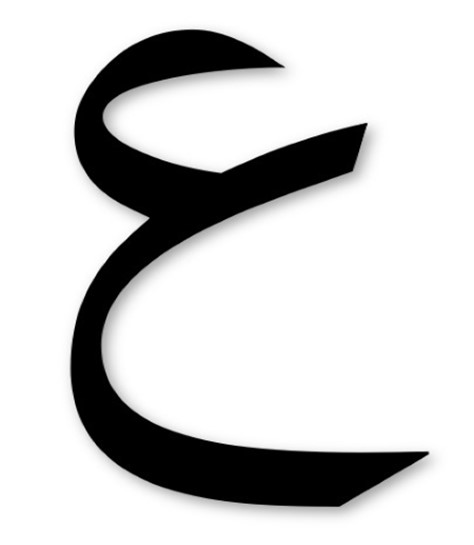The best Knowledge is that by which you perfect your growing and guidance and the worst one is that by which you spoil your Hereafter.
Ali ibn Abi Talib (as)
Table of Contents
ToggleThis article delves into the similarities and differences between these two letters, exploring their historical background, phonetic features, orthographic distinctions, and usage in the Arabic language.
Historical Background
Origins of the Arabic Alphabet
The origins of the Arabic alphabet can be traced back to the ancient Semitic scripts, particularly the Nabataean script, which emerged around the 4th century CE.
The Nabataeans, a nomadic tribe that settled in what is now Jordan and parts of Saudi Arabia, adapted their writing system from earlier Phoenician scripts.
This adaptation was crucial as it marked a significant evolution in written communication within the Arab world.
The Nabataean script featured a more cursive form than its predecessors, allowing for faster writing and greater efficiency in record-keeping and trade.
As Islam spread throughout the Arabian Peninsula in the 7th century CE, so too did the use of this evolving script.
The Sacred Quran, regarded as the holy book of Islam, was revealed during this period and played an instrumental role in standardizing Arabic script.
Scholars began to formalize and refine written Arabic to ensure accurate transmission of religious texts. Consequently, this led to significant developments such as diacritics—marks added to letters to indicate vowel sounds—which were introduced later during the Umayyad Caliphate (661-750 CE) for clarity in pronunciation.
Furthermore, by examining early manuscripts and inscriptions from both pre-Islamic and Islamic periods, researchers have identified various regional dialects that influenced the script’s development.
Over time, these adaptations culminated into what we recognize today as modern Arabic script—a consonantal alphabet consisting of 28 letters.
The historical trajectory of the Arabic alphabet not only reflects linguistic evolution but also embodies cultural shifts within Arab society itself.
The Arabic alphabet has its roots in the Nabataean script, which evolved into the modern Arabic script around the 4th century CE. The alphabet comprises 28 letters, each representing a consonant.
Over time, the script adapted to suit the phonetic requirements of the Arabic language, giving rise to unique letters like (ع) and (ء).
Development of (ع) and (ء)
The development of the Arabic letters (ع) ‘Ayn and (ء) Hamza is a fascinating aspect of the evolution of the Arabic script, reflecting both linguistic and cultural dynamics.
The letter (ع), which represents a voiced pharyngeal fricative sound, has its origins traced back to ancient Semitic scripts.
Its shape has undergone various transformations, from the Proto-Sinaitic alphabet to the Phoenician script, before taking on its current form in Arabic.
This evolution illustrates not only phonetic changes but also the influence of different cultures and languages that interacted with early Arab tribes.
In contrast, (ء) Hamza serves as a critical phonetic marker in Arabic orthography.
It denotes a glottal stop and plays an essential role in distinguishing meanings between words that would otherwise be homographs.
The introduction of Hamza into written Arabic can be attributed to the need for clarity in pronunciation, particularly as literacy spread among diverse population with varying dialects.
Initially represented by diacritical marks or combined with other letters, Hamza eventually became a distinct letter within the Arabic alphabet through historical linguistic developments.
The coexistence and differentiation of (ع) and (ء) underscore significant aspects of Arabic phonology and orthography.
While both letters contribute uniquely to word formation and meaning, their historical trajectories reflect broader trends in language development influenced by sociocultural factors.
The letter (ع), known as ‘Ayn, and (ء), known as Hamza, have distinct origins within the script. ‘Ayn has always been a part of the phonetic landscape of Arabic, representing a pharyngeal voiced fricative sound. On the other hand, Hamza was introduced to represent the glottal stop, a sound that was previously unrepresented in the script.
Both letters play crucial roles in distinguishing word meanings and pronunciation.

Phonetic Characteristics
Pronunciation of (ع)
The Arabic letter (ع), known as “Ayn” holds a significant place in the phonetic structure of the Arabic language.
It is classified as a voiced pharyngeal fricative, which distinguishes it from many other sounds found in both Semitic languages and those outside this family.
This unique articulation occurs by constricting the throat while simultaneously vibrating the vocal cords, producing a sound that is not easily replicated by speakers of non-Semitic languages.
The complexity of (ع) makes it a challenging sound for learners of Arabic, particularly those whose native languages do not contain similar phonemes.
In terms of pronunciation, (ع) manifests itself in various dialects across the Arab world, leading to variations that influence both spoken and written forms. For instance, some dialects may exhibit a more guttural quality, while others might produce a softer variant. This variation can affect communication and comprehension among speakers from different regions.
In classical Arabic and Modern Standard Arabic, however, there remains an established standard for its pronunciation that emphasizes clarity and consistency across contexts.
Furthermore, the presence of (ع) within words can alter their meanings significantly; thus, understanding its correct pronunciation is critical for effective communication in Arabic. Phonetic studies have shown that mispronunciation can lead to misunderstandings or misinterpretations of messages conveyed in speech.
As such, mastering the pronunciation of (ع) is essential not only for linguistic competence but also for cultural integration within Arabic-speaking communities.
Pronunciation of (ء)
The Arabic letter “ء,” known as “Hamzah,” holds a significant position within the Arabic alphabet, serving as both a consonant and a diacritical mark. Its unique pronunciation is pivotal to the phonetic structure of the language.
The Hamzah can appear in different forms, such as at the beginning, middle, or end of words, each influencing its phonetic realization. When occurring at the beginning of a word, it is pronounced distinctly and may be represented by an initial glottal stop.
This feature positions it as one of the fundamental sounds in Arabic phonetics.
Moreover, the Hamzah can manifest in various contexts that alter its articulation. For instance, when it appears within a word (medial position), it often combines with preceding or following vowels to create intricate vowel sounds that reflect regional dialectical variations.
This phenomenon underscores the importance of understanding regional accents when teaching or learning Arabic pronunciation. Additionally, in some dialects, particularly colloquial forms of Arabic spoken across different countries, native speakers may exhibit variations in their use or pronunciation of the Hamzah.
Orthographic Differences
Visual Distinction
The character (ع) is characterized by its circular shape with a tail that extends downwards to the left.
This unique form is not only aesthetically significant but also plays a vital role in phonetics as it represents a voiced pharyngeal fricative sound.
In contrast, (ء), known as Hamzah, is visually simpler; it appears as a small mark or diacritic placed above or below another letter or can stand alone on its own line.
The distinction between these two letters is essential for learners of Arabic because they represent different phonetic sounds and serve different grammatical functions.
The visual difference between (ع) and (ء) underscores their respective roles within Arabic script.
While (ع) serves as a consonant with its own intrinsic value within syllables, (ء) often acts as a glottal stop that may occur at the beginning of words or in conjunction with other letters to modify pronunciation.
For example, when combined with certain vowels, Hamzah alters their articulation significantly.
This importance of visual representation extends beyond mere aesthetics; it encapsulates fundamental aspects of pronunciation and meaning within the language.
Therefore, recognizing these characters not only enhances one’s reading proficiency but also enriches one’s overall comprehension of Arabic linguistic structures.
Position in Words
(ع) ‘Ayn’ is classified as a voiced pharyngeal fricative, which presents challenges for non-native speakers due to its articulation deep in the throat. Its position within a word can vary; it may appear at the beginning, middle, or end.
For instance, when (ع) occurs at the beginning of a word like “عربي” (Arabi), it sets a tonal quality that influences subsequent sounds. In contrast, its medial position can alter vowel sounds preceding or following it, as seen in “مَعْلَم” (Ma‘lam).
The placement of ‘Ayn’ often signifies particular grammatical functions or roots that are central to understanding meaning in Arabic lexicon.
- Initial: عزيز (Aziz)
- Medial: تعليم (teaching)
- Final: سمع (heard)
On the other hand, (ء) ‘Hamza’ represents a glottal stop and serves as an orthographic marker rather than a phoneme with inherent sound value.
It can appear alone or integrated with other letters such as أ (Alif), إ (Alif with Hamza below), or ؤ (Waw with Hamza). The presence of Hamza at various positions—initially in “أحمد” (Ahmad), medially in “شَيْء” (Shay’), or finally in “بَسَطَ”—affects pronunciation and syllable structure significantly.
Therefore, mastering the usage of both (‘Ayn’ and ‘Hamza’) is crucial for achieving fluency and comprehension within the Arabic language.
- On Alif: أكل (ate)
- On Waw: سؤال (question)
- On Ya: مسؤول (responsible)
- Standalone: أ (at the beginning of a word)

Usage in Arabic Language
Lexical Significance
Both letters hold significant lexical importance. The presence or absence of (ع) or (ء) can change the meaning of words drastically. For instance:
- (عمر) عمر (Omar)
- (أمر) أمر (command)
Grammatical Implications
In Arabic grammar, these letters also have implications. The Hamza, for instance, is critical in forming certain grammatical structures like the interrogative particle “أ” (a) used to form yes/no questions.
Common Confusions and Misconceptions
Pronunciation Challenges
The letter (ع), or ‘Ayn, is a voiced pharyngeal fricative produced by constricting the throat while simultaneously vibrating the vocal cords.
This sound requires precise control of the vocal tract, making it difficult for learners whose native languages lack similar phonemes. In contrast, (ء), or Hamza, represents a glottal stop—a brief closure at the vocal cords that interrupts airflow.
This distinction in articulation can lead to significant differences in meaning; for instance, “عَلَم” (alam) means “flag,” while “أَلَم” (alam) translates to “pain.” Such nuances highlight the importance of mastering these sounds for effective communication in Arabic.
Moreover, regional dialects further complicate these pronunciation challenges.
In some dialects, such as Egyptian Arabic, variations in the articulation of both ‘Ayn and Hamza may occur.
These differences can lead to confusion not only among non-native speakers but also within different Arab communities themselves. Consequently, effective pedagogical strategies must be employed to address these challenges through targeted practice and exposure to authentic spoken Arabic.
Understanding and mastering these sounds is crucial for linguistic competence and cultural integration within Arabic-speaking contexts.
Writing Errors
Misplacing (ع) and (ء) in writing can lead to misunderstandings. For example, confusing “على” (on) with “ألا” (that not) can change the meaning of a sentence entirely.
Pedagogical Approaches
Teaching (ع) and (ء)
Teaching the Arabic letters “ع” (Ayn) and “ء” (Hamzah) is crucial for learners of the Arabic language, as these letters represent unique phonetic sounds that are not present in many other languages.
The letter “ع” is a voiced pharyngeal fricative that requires specific vocal cord positioning, making it particularly challenging for non-native speakers.
Its pronunciation involves constricting the throat while simultaneously vibrating the vocal cords, which can be difficult to master without proper guidance.
Educators must employ various techniques, such as auditory discrimination exercises and physical demonstrations, to assist students in achieving accurate pronunciation.
In contrast, the letter “ء,” or Hamzah, serves a different linguistic function within Arabic. It represents a glottal stop and may appear at the beginning, middle, or end of words.
Teaching Hamzah requires an understanding of its contextual applications; for instance, its presence can alter meaning significantly when attached to certain root words. Instruction should emphasize not only its correct articulation but also its role in word formation and grammar.
Visual aids and interactive activities can enhance comprehension by allowing students to practice identifying and using Hamzah in various contexts.

Resources for Learning
Several resources are available for learning Arabic pronunciation, including online courses like Tajwid courses in DarulQuran Academy , language apps, and textbooks focused on Arabic phonetics.
Modern Usage and Adaptations
Digital Representations
In the digital age, representing these letters accurately is crucial. Unicode provides distinct codes for (ع) and (ء), ensuring they are displayed correctly across digital platforms.
Influence on Other Languages
The influence of Arabic on other languages is a testament to its historical significance and cultural richness.
As one of the oldest and most widely spoken languages in the world, Arabic has played a pivotal role in shaping various linguistic landscapes, particularly due to its historical connections with trade, religion, and scholarship.
The spread of Islam from the 7th century onwards facilitated the dissemination of Arabic across diverse regions, leading to substantial linguistic borrowing and integration into local languages.
One notable example of this influence is observed in the lexicon of many languages that have interacted with Arabic speakers.
For instance, Spanish contains numerous words derived from Arabic due to the Moorish presence in the Iberian Peninsula from 711 to 1492.
Terms such as “algebra,” “zenith,” and “saffron” reveal how deeply embedded Arabic vocabulary has become within Spanish language and culture.
Similarly, languages like Persian and Turkish have also incorporated a significant number of Arabic loanwords, particularly in areas related to administration, science, and religion.
Moreover, beyond vocabulary acquisition, Arabic has influenced phonetics and grammatical structures in several languages.
For instance, certain sounds unique to Arabic have been adopted by neighboring languages through contact.
The impact is not limited to lexical items; it extends into literary traditions as well where themes from classical Arabic literature resonate within Persian poetry or South Asian Urdu compositions.
Thus, understanding the influence of Arabic on other languages not only highlights its linguistic contributions but also underscores broader socio-cultural interactions throughout history.
In Conclusion the Arabic letters (ع) and (ء) are distinctive in their phonetic and orthographic properties. Understanding these differences is essential for mastering Arabic pronunciation and writing. Their unique roles in the language highlight the richness and complexity of Arabic.

















